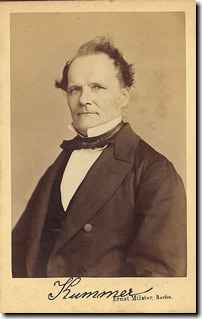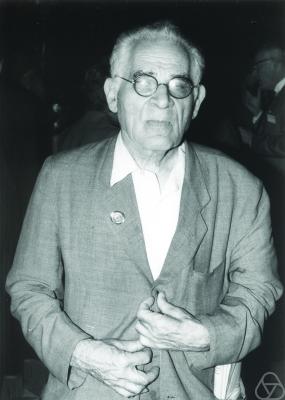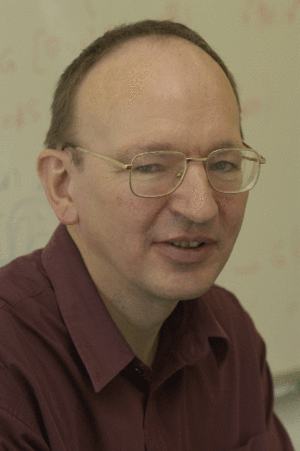<Back to Index>
- Mathematician Ernst Eduard Kummer, 1810
- Mathematician Louis Joel Mordell, 1888
- Mathematician Gerd Faltings, 1954
PAGE SPONSOR

Ernst Eduard Kummer (29 January 1810 – 14 May 1893) was a German mathematician. Skilled in applied mathematics, Kummer trained German army officers in ballistics; afterwards, he taught for 10 years in a gymnasium, the German equivalent of high school, where he inspired the mathematical career of Leopold Kronecker.
Kummer was born in Sorau, Brandenburg (then part of Prussia). Kummer was first married to Ottilie Mendelssohn, daughter of Nathan Mendelssohn and Henriette Itzig. Ottilie was a cousin of Felix Mendelssohn and his sister Rebecca Mendelssohn Bartholdy, the wife of the mathematician Peter Gustav Lejeune Dirichlet. His second wife, Bertha was a maternal cousin of Ottilie. Overall, he had 13 children. His daughter Marie married the mathematician Hermann Schwarz. Kummer retired from teaching and from mathematics in 1890 and died three years later in Berlin.
Kummer made several contributions to mathematics in different areas; he codified some of the relations between different hypergeometric series, known as contiguity relations. The Kummer surface results from taking the quotient of a two - dimensional abelian variety by the cyclic group {1, −1} (an early orbifold: it has 16 singular points, and its geometry was intensively studied in the nineteenth century). Kummer's function, Kummer ring and Kummer sum are named in his honor.
Kummer also proved Fermat's last theorem for a considerable class of prime exponents (regular prime, ideal class group). His methods were closer, perhaps, to p-adic ones than to ideal theory as understood later, though the term 'ideal' arose here. He studied what were later called Kummer extensions of fields: that is, extensions generated by adjoining an nth root to a field already containing a primitive nth root of unity. This is a significant extension of the theory of quadratic extensions, and the genus theory of quadratic forms (linked to the 2-torsion of the class group). As such, it is still foundational for class field theory.

Louis Joel Mordell (28 January 1888 – 12 March 1972) was a British mathematician, known for pioneering research in number theory.
He was born in Philadelphia, USA, in a Jewish family of Lithuanian extraction. He came in 1906 to Cambridge to take the scholarship examination for entrance to St John's College, and was successful in gaining a place and support.
Having taken third place in the Mathematical Tripos, he began independent research into particular diophantine equations: the question of integer points on the cubic curve, and special case of what is now called a Thue equation, the Mordell equation
- y2 = x3 + k.
He took an appointment at Birkbeck College, London in 1913. During World War I he was involved in war work, but also produced one of his major results, proving in 1917 the multiplicative property of Ramanujan's tau - function. The proof was by means, in effect, of the Hecke operators, which had not yet been named after Erich Hecke; it was, in retrospect, one of the major advances in modular form theory, beyond its status as an odd corner of the theory of special functions.
In 1920 he took a teaching position in Manchester College of Technology, becoming the Fielden Reader in Pure Mathematics at the Victoria University of Manchester in 1922 and Professor in 1923. There he developed a third area of interest within number theory, geometry of numbers. His basic work on Mordell's theorem is from 1921-2, as is the formulation of the Mordell conjecture.
He took British citizenship in 1929. In Manchester he also built up the department, offering posts to a number of outstanding mathematicians who had been forced from posts on the continent of Europe. He brought in Reinhold Baer, G. Billing, Paul Erdős, Chao Ko, Kurt Mahler, and Beniamino Segre. He also recruited J.A. Todd, P. Du Val, Harold Davenport, L.C. Young, and invited distinguished visitors.
In 1945 he returned to Cambridge as a Fellow of St. John's, when elected to the Sadleirian Chair,
and became Head of Department. He officially retired in 1953. It was at
this time that he had his only formal research students, of whom J.W.S. Cassels was one. His idea of supervising research was said to involve the suggestion that a proof of the transcendence of the Euler - Mascheroni constant was probably worth a doctorate. His book Diophantine Equations (1969) is based on lectures, and gives an idea of his discursive style.


Gerd Faltings (born July 28, 1954 in Gelsenkirchen - Buer) is a German mathematician known for his work in arithmetic algebraic geometry.
From 1972 to 1978, he studied mathematics and physics at the University of Münster. In 1978 he received his PhD in mathematics and in 1981 he got the venia legendi (Habilitation) in mathematics, both from the University of Münster. During this time he was an assistant professor at the University of Münster. From 1982 to 1984, he was professor at the University of Wuppertal. After that he was professor at Princeton University (1985 – 1994).
He was awarded the Fields Medal in 1986 for proving the Mordell conjecture, which states that any non - singular projective curve of genus g > 1 defined over a number field K contains only finitely many K - rational points.
Since 1994 he has been a director of the Max Planck Institute for Mathematics in Bonn. In 1996, he received the Gottfried Wilhelm Leibniz Prize of the Deutsche Forschungsgemeinschaft, which is the highest honor awarded in German research.